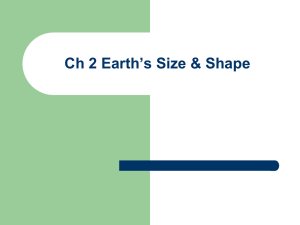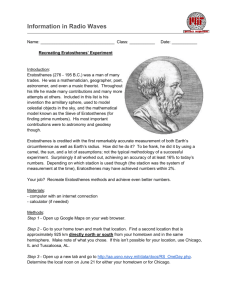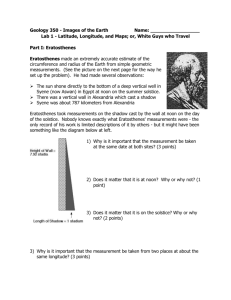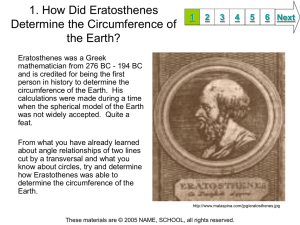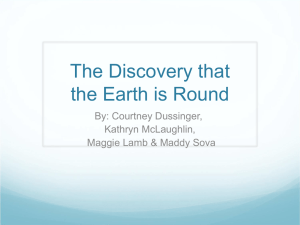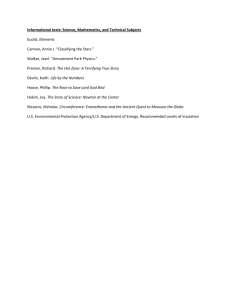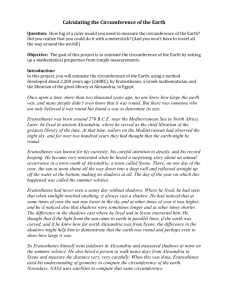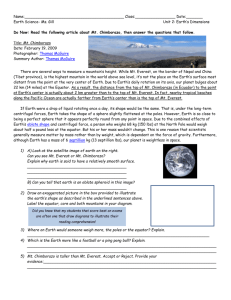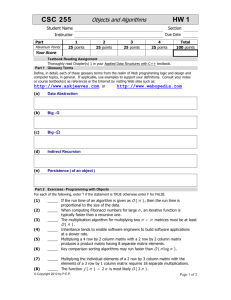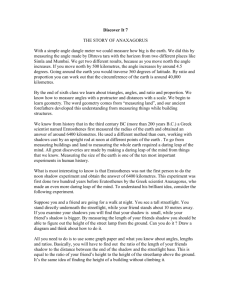Calculate Your Latitude and Earth`s Circumference
advertisement
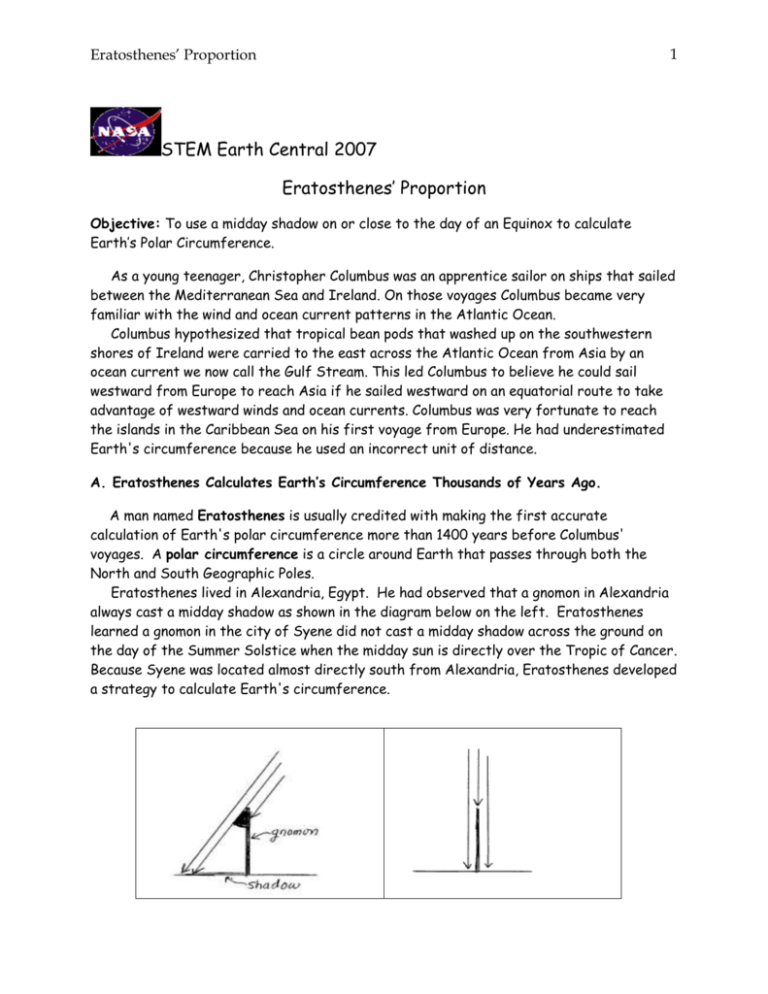
1 Eratosthenes’ Proportion STEM Earth Central 2007 Eratosthenes’ Proportion Objective: To use a midday shadow on or close to the day of an Equinox to calculate Earth’s Polar Circumference. As a young teenager, Christopher Columbus was an apprentice sailor on ships that sailed between the Mediterranean Sea and Ireland. On those voyages Columbus became very familiar with the wind and ocean current patterns in the Atlantic Ocean. Columbus hypothesized that tropical bean pods that washed up on the southwestern shores of Ireland were carried to the east across the Atlantic Ocean from Asia by an ocean current we now call the Gulf Stream. This led Columbus to believe he could sail westward from Europe to reach Asia if he sailed westward on an equatorial route to take advantage of westward winds and ocean currents. Columbus was very fortunate to reach the islands in the Caribbean Sea on his first voyage from Europe. He had underestimated Earth's circumference because he used an incorrect unit of distance. A. Eratosthenes Calculates Earth’s Circumference Thousands of Years Ago. A man named Eratosthenes is usually credited with making the first accurate calculation of Earth's polar circumference more than 1400 years before Columbus' voyages. A polar circumference is a circle around Earth that passes through both the North and South Geographic Poles. Eratosthenes lived in Alexandria, Egypt. He had observed that a gnomon in Alexandria always cast a midday shadow as shown in the diagram below on the left. Eratosthenes learned a gnomon in the city of Syene did not cast a midday shadow across the ground on the day of the Summer Solstice when the midday sun is directly over the Tropic of Cancer. Because Syene was located almost directly south from Alexandria, Eratosthenes developed a strategy to calculate Earth's circumference. 2 Eratosthenes’ Proportion B. A proportion can be used to analyze a circle. The circle shown below is divided into 8 equal sections. If the number of degrees in a circle is 8 times bigger than angle “a”, then the circumference of the circle is also 8 times bigger than distance “d”. The folowing proportion can use to calculate the circumference of the circle. D d = _360°_ a D is the circumference of the circle. d is the distance of one section of the circumference. a is the number of degrees in angle “a”. C. Eratosthenes' Proportion Eratosthenes used a similar proportion to calculate Earth’s circumference. He assumed correctly that the Sun is very large and very far from Earth. That meant that rays of sunlight that reach Earth's surface are parallel to each other. Then Eratosthenes hypothesized that Earth had to be a sphere if midday shadows in Alexandria were different from midday shadows in Syene at the same time on the same day. The diagram below is very similar to the diagram the Eratosthenes constructed. On a Summer Solstice, sunlight hit the top of a gnomon in Syene and no shadow was cast across the ground. On that same day, in Alexandria, there was a shadow of the gnomon at midday. Eratosthenes had soldiers measure the distance “d” from Alexandria to Syene. But Eratosthenes could not go to the center of Earth to measure the number of degrees in angle “a”. Eratosthenes’ Proportion 3 D. Eratosthenes' Mathematical Observations. Eratosthenes was a clever mathematician. He noticed that the gnomon (located in Alexandria) and its shadow formed an imaginary right triangle. He also recognized that one of the angles in that right triangle was equal to angle “a” at the center of Earth. Question 1: What angle in the imaginary right triangle would be equal to angle “a” at the center of Earth? E. You can use Eratosthenes on an Equinox. There are two days each year when Eratosthenes can easily be used to calculate Earth’s Polar circumference. Those days are the Fall and Spring Equinoxes when the midday sun shines directly down on the Equator. In the diagram below, the gnomon on the Equator does not cast a shadow across the ground. The gnomon that is located north of the Equator casts a midday shadow across the ground. Gnomons in the Southern Hemisphere would also cast a midday shadow on an Equinox. You can prepare to use Eratosthenes proportion to calculate Earth’s Polar circumference. Question 2: Why would it be fairly easy to determine the value for “d” on an Equinox? Question 3: Why would angle “a” be equal to Latitude on an Equinox? F. What time is Midday? Some people thing that midday is at 12:00 noon. But that is true only several times a year if you live on a time meridian in a time zone. The 75º Longitude line is the time meridian in the Eastern Time Zone. There are three corrections you can make to determine the time of midday. Convert Daylight Savings Time to Standard Time. Subtract 4 minutes from 12:00 Standard Time for each degree of Longitude you are East of the Time Meridian or add 4 minutes to 12:00 Standard Time for each degree of Longitude you are West of the Time Meridian. Consult the Sky Gazer’s Almanac for a description of how to use the Equation of Time line to make an additional correction. Eratosthenes’ Proportion 4 G. Determine Angle "a" Put a gnomon on level ground at midday on an Equinox. Construct a scale drawing of the gnomon and its midday shadow. Construct a hypotenuse. Use a protractor to measure the angle between the top of the line that represents the gnomon and the hypotenuse of the right triangle. Question 4: How does your value for angle "a" compare with the Latitude indicated by your GPS device or by using Latitude rulers on a USGS map? Question 5: What might be some possible sources of error in your value for angle "a"? H. Let Your GPS or Latitude Rulers Do the Walking Eratosthenes determined the value for distance "d" for his proportion by having soldiers march from Alexandria to Syene. It would be very difficult for you to use a meter stick to measure distance as you marched directly South to the Equator. Method A: Use your GPS to get a value for “d”. Create, name and save a Waypoint for your Longitude and a Latitude of 0º. Then set one of the data fields on the Pointer Page to “Distance to Next”. The press GOTO and select the Waypoint at the Equator. When you start to walk toward the Equator, the Distance to Next data field will indicate how far you would have to walk. On days other than an Equinox, you can use the following web site to determine the Latitude where the midday sun is directly overhead. http://aa.usno.navy.mil/data/docs/earthview.html Method B. Latitude rulers and the distance scales at the bottom of a USGS topographic map can be used to determine how many kilometers or miles there are in a minute and then in a degree of Latitude. Then you can calculate the distance to the Equator. Question 6: What is your value for distance “d”? I. Use Eratosthenes' Proportion You can use now Eratosthenes' Proportion to calculate Earth's circumference (“D”) on an Equinox. D = _360°_ d a Question 7: What is your value for Earth's polar circumference? Show your work. Question 8: What is an accepted value for Earth's polar circumference? Question 9: What is your percent error? Show your work. Question 10: What are possible sources of error in your calculation?
